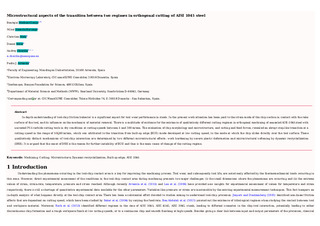| dc.contributor.author | Saez de Buruaga, Mikel | |
| dc.contributor.author | Soler Mallol, Daniel | |
| dc.contributor.author | ARRAZOLA, PEDRO JOSE | |
| dc.contributor.other | Medina Clavijo, Bentejui | |
| dc.contributor.other | Motz, Christian | |
| dc.contributor.other | Chuvilin, Andrey | |
| dc.date.accessioned | 2022-10-25T17:07:14Z | |
| dc.date.available | 2022-10-25T17:07:14Z | |
| dc.date.issued | 2018 | |
| dc.identifier.issn | 0924-0136 | en |
| dc.identifier.other | https://katalogoa.mondragon.edu/janium-bin/janium_login_opac.pl?find&ficha_no=147800 | en |
| dc.identifier.uri | https://hdl.handle.net/20.500.11984/5761 | |
| dc.description.abstract | In depth understanding of tool-chip friction behavior is a significant aspect for tool wear performance in steels. In the present work attention has been paid to the strain mode of the chip section in contact with the rake surface of the tool, and its influence on the mechanics of material removal. There is a multitude of evidence for the existence of qualitatively different cutting regimes in orthogonal machining of annealed AISI-1045 steel with uncoated P15 carbide cutting tools in dry conditions at cutting speeds between 5 and 200 m/min. The evaluation of chip morphology and microstructure, and cutting and feed forces, revealed an abrupt step-like transition at a cutting speed in the range of 50–60 m/min, which was attributed to the transition from built-up edge (BUE) mode developed at low cutting speed, to the mode at which the chip slides directly over the tool surface. These qualitatively distinct mechanisms of tool-chip interaction are determined by two different microstructural effects: work hardening by severe plastic deformation and microstructural softening by dynamic recrystallization (DRX). It is argued that the onset of DRX is the reason for further instability of BUE and thus is the main cause of change of the cutting regime. | es |
| dc.description.sponsorship | Gobierno Vasco-Eusko Jaurlaritza | es |
| dc.language.iso | eng | en |
| dc.publisher | Elsevier | en |
| dc.rights | © 2018 Elsevier | en |
| dc.subject | Machining | en |
| dc.subject | Cutting | en |
| dc.subject | Microstructure | en |
| dc.subject | Dynamic recrystallization | en |
| dc.subject | Built-up edge | en |
| dc.subject | AISI 1045 | en |
| dc.title | Microstructural aspects of the transition between two regimes in orthogonal cutting of AISI 1045 steel | en |
| dcterms.accessRights | http://purl.org/coar/access_right/c_abf2 | en |
| dcterms.source | Journal of Materials Processing Technology | en |
| local.contributor.group | Mecanizado de alto rendimiento | es |
| local.description.peerreviewed | true | en |
| local.description.publicationfirstpage | 87 | en |
| local.description.publicationlastpage | 96 | en |
| local.identifier.doi | https://doi.org/10.1016/j.jmatprotec.2018.05.016 | en |
| local.relation.projectID | info:eu-repo/grantAgreement/GV/Convocatoria de ayudas a la Investigación básica y-o aplicada 2014-2015/PI_2014_1_116/CAPV/Estudio de la influencia de la microestructura de aceros y superaleaciones base níquel en la maquinabilidad e integridad superficial de componentes mecanizados/MICROMAQUINTE | en |
| local.relation.projectID | info:eu-repo/grantAgreement/GE/Programa Estatal de Investigación, Desarrollo e Innovación Orientada a los Retos de la Sociedad, Convocatoria 2015, Modalidad 1: Proyectos de I+D+I/DPI2015-67667-C3-3-R/ES/Modelización y análisis experimental del proceso de mecanizado en la escala micro/EMULATE | en |
| local.contributor.otherinstitution | https://ror.org/023ke8y90 | eu |
| local.contributor.otherinstitution | https://ror.org/01jdpyv68 | en |
| local.contributor.otherinstitution | https://ror.org/01cc3fy72 | eu |
| local.source.details | Vol. 260. Pp. 87–96. October, 2018 | en |
| oaire.format.mimetype | application/pdf | |
| oaire.file | $DSPACE\assetstore | |
| oaire.resourceType | http://purl.org/coar/resource_type/c_6501 | en |
| oaire.version | http://purl.org/coar/version/c_ab4af688f83e57aa | en |







